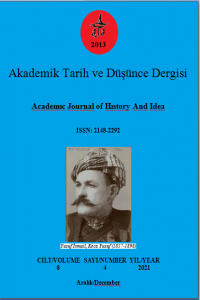Öz
Gorbachev, who came to rule as the last president of the Soviet Union, implemented reform policies called Glasnost and Perestroika. In line with these policies, there has been change and development in social, economic, political, administrative, etc. areas in the Soviet Union. The people of the Soviet Union could become part of the administration through glasnost policy in line with practices of transparency and openness in the public. Thus, the effectiveness of the people increased under the central and totalitarian Soviet Union. There has also been a change in communist party leadership in the political sphere, and the governance structure within the party, which was closed, has changed under the influence of Glasnost. With the Perestroika policy, the economic structure of the Soviet Union changed by restructuring the administration economically. In short, there has been a rapid change in the domestic and foreign policies of the Soviet Union in all areas. These reform policies which were put into effect in the Soviet Union are developments that attract the attention of the whole world. In this context, the reform policies implemented by Gorbachev were also on the agenda of The Times, one of the leading newspapers (publishing) in the UK and one of the world's leading newspapers. In this study, glasnost and perestroika policies, which were also seen as among reasons for the dissolution of the Soviet Union, were investigated how they were seen in The Times. As a result, it is seen that the newspaper was not indifferent to Gorbachev's reform policies; follows all aspects of the developments; tells Gorbachev that he should never compromise on his reform policies; mostly supports him, but he was criticized by some writers for not seriously implementing reform policies.
Anahtar Kelimeler
The Times Gorbachev Glasnost Perestroika The Times, Gorbachev, Glasnost, Perestroika
Kaynakça
- TOMPSON, W. J., “Khrushchev and Gorbachev as Reformers: A Comparison”, British Journal of Political Science, Vol. 23, Issue 1, 1993, s. 77-105.
- WALICKI, A., Marxism and the Leap to the Kingdom of Freedom: The Rise and Fall of the Communist Utopia, Stanford University Press, Stanford 1995.
- WALKER, C., “Eski Koruyucuların Son Baş Eğişi, The Times 25 Şubat 1986.
- WORCESTER, R., “Proletarya İçindeki Anketörler”, The Times 13 Ocak 1988.
- YAYLA, A., Liberal Bakışlar, Profil Yayıncılık, İstanbul 2014.
Öz
Sovyetler Birliği’nde son başkan olarak yönetime gelen Gorbaçov, Glasnost ve Perestroyka adı verilen reform politikaları uyguladı. Bu politikalar doğrultusunda Sovyetler Birliği’nde toplumsal, ekonomik, siyasi, idari vb. alanlarda değişim ve gelişim yaşandı. Sovyetler Birliği’nde yaşayan halk Glasnost politikası ile kamudaki şeffaflık ve açıklık uygulamaları doğrultusunda yönetimin bir parçası haline gelebildi. Böylece merkezi ve totaliter Sovyetler Birliği yönetiminde halkın etkinliği arttı. Siyasi alanda Komünist Parti yönetiminde de değişim yaşandı ve parti içinde Glasnost etkisiyle kapalı olan yönetim yapısı yenilendi. Perestroyka politikası ile ekonomik anlamda yönetimde yeniden yapılanma yaşanarak, iç ve dış politikalarında da her alanda hızlı bir değişim yaşandı. Sovyetler Birliği’nde uygulamaya konulan bu reform politikaları tüm dünyanın ilgisine çeken gelişmelerdir. Bu çalışmada Sovyetler Birliği’nin dağılmasının da nedenleri arasında görülen Glasnost ve Perestroyka politikalarının The Times gazetesinde nasıl görüldüğü araştırılmaya çalışıldı. Gazetenin Gorbaçov’un reform politikalarına ilgisiz kalmadığı; yaşanan gelişmeleri her yönüyle takip ettiği; Gorbaçov’a uyguladığı reform politikalarından kesinlikle taviz vermemesi gerektiğini söylediği; çoğunlukla da kendisini desteklediği ancak bazı yazarlar tarafından reform politikalarının ciddi şekilde uygulanmadığı konusunda eleştiriler yapıldığı görülmektedir.
Anahtar Kelimeler
The Times Gorbaçov Glasnost Perestroyka The Times, Gorbaçov, Glasnost, Perestroyka
Kaynakça
- TOMPSON, W. J., “Khrushchev and Gorbachev as Reformers: A Comparison”, British Journal of Political Science, Vol. 23, Issue 1, 1993, s. 77-105.
- WALICKI, A., Marxism and the Leap to the Kingdom of Freedom: The Rise and Fall of the Communist Utopia, Stanford University Press, Stanford 1995.
- WALKER, C., “Eski Koruyucuların Son Baş Eğişi, The Times 25 Şubat 1986.
- WORCESTER, R., “Proletarya İçindeki Anketörler”, The Times 13 Ocak 1988.
- YAYLA, A., Liberal Bakışlar, Profil Yayıncılık, İstanbul 2014.
Ayrıntılar
| Birincil Dil | Türkçe |
|---|---|
| Bölüm | Makaleler |
| Yazarlar | |
| Erken Görünüm Tarihi | 30 Aralık 2021 |
| Yayımlanma Tarihi | 30 Aralık 2021 |
| Yayımlandığı Sayı | Yıl 2021 Cilt: 8 Sayı: 4 |
По всем вопросам приема статей и выпуска очередных номеров обращаться в редакцию соответствующего журнала


